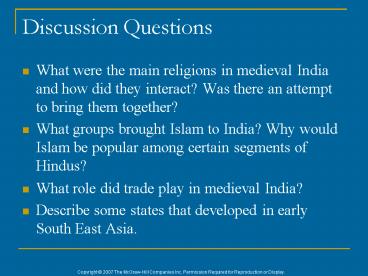Discussion Questions - PowerPoint PPT Presentation
1 / 44
Title:
Discussion Questions
Description:
Why would Islam be popular among certain segments of Hindus? ... Pongal is the only festival of Hindu that follows a solar calendar and is ... – PowerPoint PPT presentation
Number of Views:128
Avg rating:3.0/5.0
Title: Discussion Questions
1
Discussion Questions
- What were the main religions in medieval India
and how did they interact? Was there an attempt
to bring them together? - What groups brought Islam to India? Why would
Islam be popular among certain segments of
Hindus? - What role did trade play in medieval India?
- Describe some states that developed in early
South East Asia.
2
(No Transcript)
3
India after Gupta
- White Huns c. 451 CE
- Gupta State collapsed mid-6th c.
- Regionalism in N. India
- Conflicts
- Turkish invasions
- Turmoil
4
King Harsha (r. 606-648 CE)
- Unified rule N. India
- Young, energetic, competent
- Assassinated
- Decentralized control
5
King Harshas Northern India
6
Islam in Northern India
- Umayyad empire in Sind (NW India), 711
- Held by Abbasid dynasty to 1258
- Heterodox population
7
The Abbasid Caliphate at the Height of Its Power
8
http//www.mapsofworld.com/world-news/earthquake-r
attles-india-pakistan1.gif
9
Merchants and Islam
- Early Arabic trade in India
- Muslims in India
- Particularly coastal areas large cities
- Influx of Muslim settlers
10
Mahmud of Ghazni
- Raids N. India, 1001-1027
- Plunders and destroys temples
- Builds mosques
- Feared
11
The Sultanate of Delhi, 1206-1526
- Mahmuds raiding territory
- Delhi
- Weak administration
- No permanent bureaucracy
- Reliance on Hindu kings
- Violent overthrows
12
Early Islam in Northern India
13
The Delhi Sultanate Dawlatabad, Madhya, India
14
The Issue of Kashmir
15
http//www.zum.de/whkmla/histatlas/india/indiageo.
gif
16
Hindu Kingdoms of S. India Chola
- Chola Kingdom, 850-1267
- Maritime power
- Decentralized, but taxes
- Trade
- Influence Malaysia, Sri Lanka, and Bengal
17
Chola Dynasty 860-1267
18
Hindu Kingdoms of Southern India Vijayanagar
- Kingdom of Vijayanagar
- Northern Deccan
- Originally supported by Sultanate of Delhi
- Renounce Islam - 1336
- Independent until 16th c
19
Trade and Economic Development
- S. Regions largely self-sufficient
- Products traded
- Iron, copper, salt, pepper, textiles
- Instability in north
20
Trade - Indian Ocean basin, 600-1600 C.E.
21
Trade in the Indian Ocean Basin
- Trade increases - stable governments outside
India - Larger ships
- Dhows, junks
- Agricultural more organized
- Emporia
- Port cities - warehouses
- Specialized products
- cotton textiles, high-carbon steel
22
Agriculture in the Monsoon World
- Spring/summer from SW
- Fall/winter from NE
- Seasonal irrigation
- Reservoirs, canals, tunnels
23
Population Growth in India
24
Temples and Indian Society
- Religious centers
- Organize irrigation, etc.
- Large landholdings, income
- Education
- Banking
25
Challenges to Caste and Society
- Migrations
- Islam
- Urbanization
- Economic development
- Jati (guilds or subcastes)
- Caste system expands
- Promoted by temples, educational system
26
Decline of Buddhism
- Turkish invasions
- 1196 Muslim forces destroy Nalanda
- Monks exiled
27
Buddhist Migrations Pagan, Burma
28
Growth of Hinduism
- Devotional cults
- Vishnu, Shiva
- Salvation
- Philosophy
- Popular in S. India, spreads to north
29
Hindu Shrines Khajuraho Mahadeva Temple
30
Hindu Shrines Khajuraho Mahadeva Temple
Sensuousness expresses the rapturous union of
human and divine
31
Festival of Pongal Hindu Celebrations
Pongal is the only festival of Hindu that follows
a solar calendar and is celebrated on the
fourteenth of January every year. Pongal has
astronomical significance it marks the beginning
of Uttarayana, the Sun's movement northward for a
six month period. In Hinduism, Uttarayana is
considered auspicious, as opposed to
Dakshinaayana, or the southern movement of the
sun. All important events are scheduled during
this period. Makara Sankranthi refers to the
event of the Sun entering the zodiac sign of
Makara or Capricorn.
http//www.pongalfestival.org/what-is-pongal.html
32
Brahmin Devotional Philosophers
- Shankara, 9th c. CE
- Shiva
- Platonic forms
- Logical analysis
- Ramanuja, 11th-early 12th c.
- Deemphasized intellect
- Philosophical foundations of contemporary Hinduism
33
Conversion to Islam
- ¼ Total population converted
- Social status remained consistent
34
Islam Sufism
- Personal, emotional
- Missionaries
- Flexibility
- Piety and devotion rather than doctrine
35
The Bhakti Movement
- Attempt to bring Hinduism and Islam closer
together - 12th c. Hindu movement
- Shiva, Vishnu, Allah all one Deity
- Helped bridge differences
36
Indian Influence in Southeast Asia
- From 500 BCE
- Similarities with Indian culture
- Kingship
- Religions (Hinduism, Buddhism)
- Literature (Ramayana, Mahabharata)
- Differences
- Primarily rejected caste system
- Nature spirits and other deities
37
Early States of Southeast Asia
- Funan
- Lower Mekong River, 1st-6th c. CE
- Tribute to China
- Rajas
- Srivijaya
- Sumatra, 670-1025 CE
- Buddhism
- Angkor
- Cambodia, 889-1431 CE
- Religious complexes
38
Early States of Southeast Asia
39
Modern SE Asia
http//mabryonline.org/blogs/howard/archives/map_s
outheast_asia.jpg
40
Angkor Wat Cambodia
41
Islam in SE Asia
- Muslim traders
- Sufism - popular
- Monotheism
- Spiritual equality
- Trade
- Many convert, retain some Hindu or Buddhist
traditions
42
State of Melaka
- Late 14th c. CE - Prince of Sumatra
- Strait of Melaka
- Taxes
- Mid-15th c. converted to Islam
43
India Comparison
- Less centralized government
- Significant agricultural production encourages
population growth urbanization - Increased trade stimulates specialized labor
economic growth - Hindu and Muslim populations
44
http//www.rupe-india.org/34/images/map.jpg

